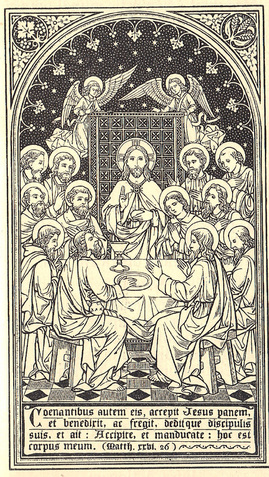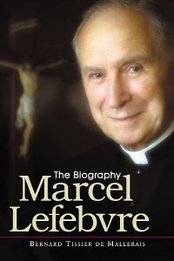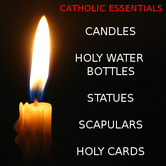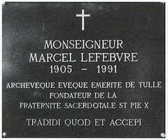
1. (OHS 1956): Introduction of the stole as part of the choir dress of priests.
Commentary: This is the beginning of the myth of concelebration on Holy Thursday. The bolder among the reformers wished to introduce it along with this reform, but resistance—especially from members of the Commission such as Cardinal Cicognani and Msgr. Dante—blocked this novelty. Father Braga writes: “As to the ‘participation’ of the priests, sacramental concelebration did not seem attainable (the mind-set, even of certain members of the Commission, was not yet prepared for it).” In effect, there was a strongly hostile feeling against concelebration on Holy Thursday because it was not traditional: “Concelebration, whether sacramental or purely ceremonial, was to be excluded.” To introduce the idea of concelebration, its proponents had to be content with the creation of the practice of having every priest present don a stole, (60) not at the moment of communion only but beginning with the start of the Mass.
(MR 1952): The priests and deacons wear the usual choir dress, without the stole, and put on the stole at the time of communion only, as is the usual custom.
2. (OHS 1956): The practice is introduced of giving communion with only those hosts consecrated on this day.
Commentary: It is incomprehensible why those present cannot communicate with hosts already consecrated previously. The Roman practice of the “Fermentum”—which is historically documented—was to communicate, in general, from a particle of the Eucharist from the Sunday prior, to show the communion of the Church throughout time and space, within the reality of the Body of Christ. This presence, being “real and substantial,” continues when the assembly departs and at the same time, with even greater logical coherence, precedes the reuniting of the assembly. With this [new] rubric, the idea is introduced of the Real Presence being tied to the day of the celebration, as well as the idea that one is obliged to communicate from hosts consecrated on the same day. It is as much as to say that those hosts are in some way different from those consecrated earlier. One should note that this obligation relates not merely to the symbolism of the tabernacle being empty before the Mass of Holy Thursday—which, at most, might have had some significance, albeit a novel one—since the text affirms that those who receive communion must receive only hosts consecrated on this day. The underlying theology does not seem very solid, while the symbolism is debatable.
(MR 1952): There is no mention of this practice of giving communion with hosts consecrated on Holy Thursday.
3. (OHS 1956): The washing of feet is no longer at the end of Mass but in the middle of Mass.
Commentary: The reform appealed to a restoration of the “veritas horarum” [i.e., observance of the “true times” of the services], an argument used in season and out, like a veritable hobby horse. In this case, however, the chronological sequence given in the Gospel is abandoned. Rivers of ink flowed in order to convince others of the scandal of an horarium that was not in full accord with that of the Gospels, but in this case not only was a rite anticipated, or postponed, for practical reasons, but the chronological order of the Gospel narrative was inverted within a single ceremony. St. John writes that Our Lord washed the feet of the Apostles after the supper: “et cena facta” [“the supper having been finished”] (John 13: 2). It escapes understanding why the reformers, for whatever obscure motive, chose, arbitrarily, to put the washing of the feet directly in the middle of Mass. While Mass is being celebrated, consequently, some of the laity are allowed to enter the sanctuary and take off their shoes and socks. Apparently there was a desire to re-think the sacredness of the sanctuary and the prohibition of the laity from entering it during divine services. The washing of feet, therefore, is spliced into the offertory, an abuse whereby the celebration of Mass is interrupted with other rites, a practice founded on the dubious distinction of Liturgy of the Word and Liturgy of the Eucharist.
(MR 1952): The rite known as the Mandatum, or washing of the feet, is carried out after Mass and not in the sanctuary, after the stripping of the altars and without interrupting Mass or allowing the laity to enter the sanctuary during the service, and withal respecting the chronological sequence given in the Gospel.
4. (OHS 1956): Omission of the Confiteor recited by the deacon before Holy Communion.
Commentary: The third, despised Confiteor is done away with, without recognition of the fact that the confession made by the deacon, or the server, although borrowed from the rite for communion extra missam [outside of Mass], is a confession of the unworthiness of the communicants to receive the sacred Species. It is not a “duplication” of the confession made by the priest and ministers at the beginning of Mass, since at that point they have simply recited their own unworthiness to approach the altar and to celebrate the sacred mysteries. (Hence, at a sung Mass it is recited sotto voce.) This is distinct from one’s unworthiness to approach Holy Communion.
(MR 1952): The Confiteor is recited before communion.
5. (OHS 1956): At the end of Mass, during the stripping of the altars, it is mandated that even the cross and candlesticks are to be removed.
Commentary: It was decided that everything should be stripped from the altar, even the cross. The rubrics of the reformed Holy Thursday do not explain, however, what to do with the altar cross, but one learns this by accident, as it were, from the rubrics of the following day. In effect, the rubrics of Good Friday speak of an altar without a cross, which one can deduce from the fact that it was taken away during the stripping of the altars, or perhaps in a more private manner during the night. (This and other problems arise when one changes a liturgy which has benefited from layers of tradition and which is all but intolerant of hasty alterations.) Perhaps, on the basis of a certain liturgical archeologism, the reformers wished to prepare souls for the spectacle of a bare table in the middle of the sanctuary—something which makes little sense theologically.
(MR 1952): The cross remains on the altar, veiled and accompanied by the candlesticks, enthroned there in expectation of being unveiled the following day.
GOOD FRIDAY CHANGES




